Time control
The time control panel is an integral part of Firetail. It enables quick navigation of datasets.
- modify the current timestamp (across individuals)
- set timestamps manually
- set a Firetail length (tail length)
- select time brackets (time slicing)
- select next/previous time bracket
- set step-length for interval analysis
- set replay speed
- replay the dataset

GPS tracking data is focused on timestamps that are enriched with location data, acceleration data or spatial orientation data. Thus, the central unit common to all Firetail data is a timestamp, a measurement.
Note that acceleration data does not necessarily align to GPS data directly, for it may not exist for every GPS sample and vice versa. Instead, this kind of data is often transmitted from the tags (sender units) as bursts starting at a defined timestamp.
In particular
Firetail follows some concepts to visualize time:
- a currently active timestamp
- a restricted time window
- a step length
Current time stamp
Whenever you load data into firetail, the complete dataset will be shown by
default. Each entity (acceleration data, GPS data) will be separately visible
in the Open Files Panel (see Open Files).
All selected entities are shown in the map. If associated data (reference data, acc data)
is found the data will be opened together.
You may then use the time control panel

to set the current timestamp by shifting the slider. The currently selected
timestamp is shown as current time.
The earliest available timestamp in the data is shown as Start Time.
The latest available timestamp in the data is shown as End Time.
The dropdown menu is used to select the desired step length, see Section Step Length
Hint: fine-grained selections are possible via arrow left and arrow right on your keyboard.
In the map, Firetail highlights the coordinates associated to this timestamp for all selected individuals/tags.
- Press
lto toggle labels in the map - Press
cto toggle coordinates in the map
Bookmarking
Firetail offers a bookmarking feature for both the selected time ranges and the selected set of individuals.
 Bookmarks Dialog
Bookmarks Dialog
Basic bookmarking
- Hit the
bookmarkicon in the time control section (keyboard shortcutCtrl-b) to open the bookmarks window - Hit the icon again or press
Ctrl-bto add a new bookmark for the current selection - Double click a line to load this bookmark
When loading a bookmark, you may loose your selection of sensor checkboxes. Check keep sensor states to
maintain the sensor selection of your Open Files tree.
Removing a bookmark
- Open the bookmarks window
- Hold
Ctrland left-click the line of the bookmark you wish to remove
Saving default bookmarks
- Create a set of bookmarks
- Press
Saveto save the current set of bookmarks as the default on startup
Saving bookmarks in specific files
You can save and share bookmarks:
- Open the bookmarks window
- Create a set of bookmarks
- Press
Save to...and navigate to a location for your bookmarks - Choose
.csvor.json; Note that.csvis export only (Excel etc.), json can be re-imported - Choose a name and confirm
Loading bookmarks from specific files
To load previously saved bookmarks, you may import .json bookmarks previously exported.
- Open the bookmarks window
- Press
Load from...and select a Firetail bookmarks file
To avoid loss of bookmarks this will add the bookmarks to the set of existing bookmarks.
Choose Clear bookmarks to remove any previous collection.
Bookmarks descriptions
Each bookmark offerst a note column that allows for entering custom text.
This column can hold annotations to effectively annotate the currently active set of individuals at a certain time.
Exporting as csv will allow downstream applications like R, matlab, SPSS and others to make
use of this data.
Follow an individual
Toggle Follow to enable automatic window scrolling. This will keep the currently selected individuals centered.
The zoom level does not change.
Manually entering a timestamp
Firetail allows to edit timestamps as plain text. Click on either
- start time
- current time
- end time
to edit the timestamp.
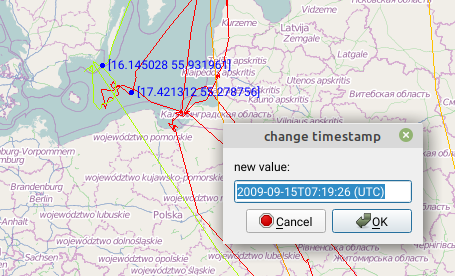
Note that the Current Time cannot be
- earlier than the start time
- later than the end time
Similarly the
Start Timecannot be set after theCurrent TimeEnd Timecannot be set before theCurrent Time
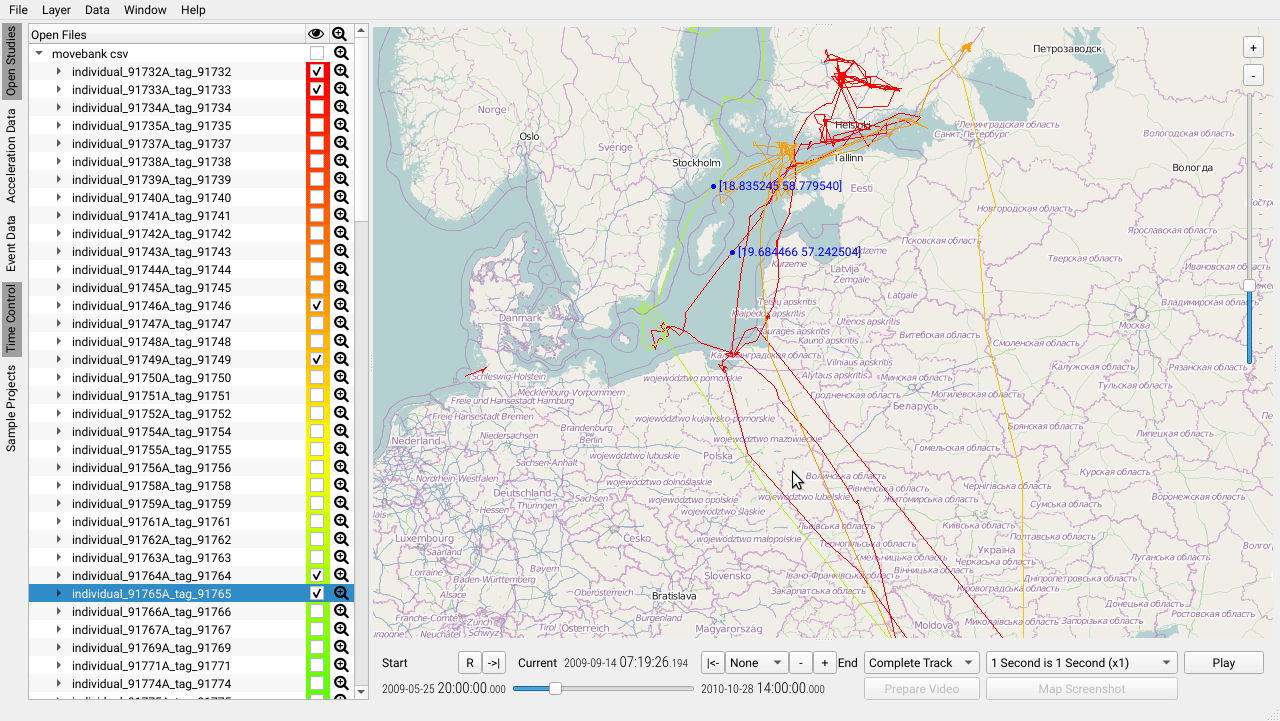
Whenever start and end time are set manually time bracketing is active (timestamps are shown in blue). See Section focusing on a time window – bracketing for more details.
Note: Firetail works using ISO timestamps, so make sure to use
01instead of1
Selecting a timestamp from the map
In order to see when a given GPS coordinate was sent, you can double-click on a GPS trajectory drawn in the map view. The nearest timestamp will become

focusing on a time window – bracketing
When working with time series data that was captured over long periods of time it may become increasingly difficult to observe regions of interest. Firetail borrows a simple concept from video editing: bracketing.
You may define two timestamps (start and end) that define a time interval (window) that you want to restrict to.
- use the slider/editing to select the current timestamp as your targeted start timestamp
- press
|<-to fix this timestamp as your interval start (bracket open) - use the slider/editing to select a stop timestamp
- press
->|to fix this timestamp as your interval end (bracket close)
The slider will now be restricted to your new intervals.
Use the reset bracketing button R to revert to dataset defaults.

The restricted interval can be restricted further and more fine-grained analysis can be performed and more precise selections are possible.
Step length
When analyzing data it is often required to step through your data with predefined
steps. When selecting a step length from the drop-down window (next to +, -)
bracketing is activated for the chosen interval (minute, hour, day). The center of
the bracket is the current timestamp (slider).
You may then use the + (‘next interval’) and - (‘previous interval’) control to
move through the data by days, hours, minutes and so on.
Hint: This feature is especially powerful in combination with the firetails (see below) feature. Limiting the visible trajectories and jumping defined intervals allows a step-wise analysis of your data.
Below: baboons crossing a river
- manual editing with a saved (copy-paste) timestamp is used to jump to a point of interest
- the firetail is set to 3h, showing the trajectories
- the step size is set to 1h,
+/-is used to jump to the next 1h interval - the step size is increased to 1 day, the firetail is increased to 7 days
- daily data is explored by jumping in intervals of 1 day

replay speed
To get an impression of behaviour or trends it is necessary to visualize
the GPS position as a function of time. By default, firetail will replay
all the timestamps in realtime when you hit the Play button (and thereby
update the currently selected time).
By selecting a replay speed you may speed up the replay or even observe the captured data in slow motion. There are two ways to define the speedup:
- define
1 second is n seconds(n is the interval of timestamps visualized in one second) - define
k seconds duration(k seconds to play the complete active interval)
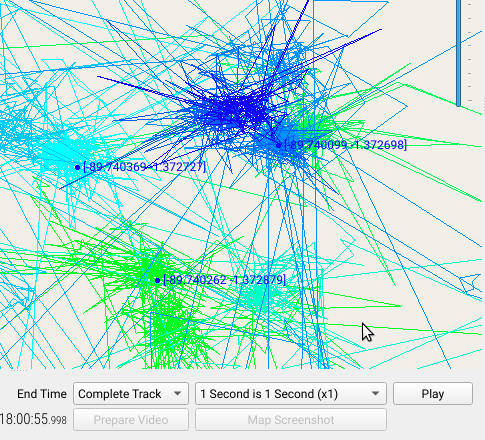
Firetails – interval visualisation
It is often useful to not only precisely select intervals via bracketing, but also restrict the visualized data to a user selected time period, e.g. to avoid a cluttered viewport.
The interval restriction dropdown menu provides you with a selection of time ranges to decide
which range of data should be visible:
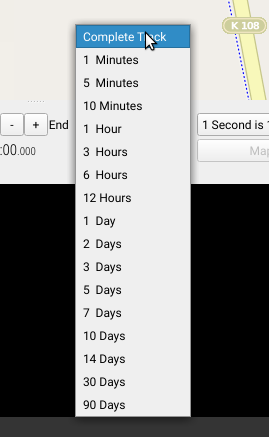
In this way, you can view past (given the selected timestamp) and future behavior:
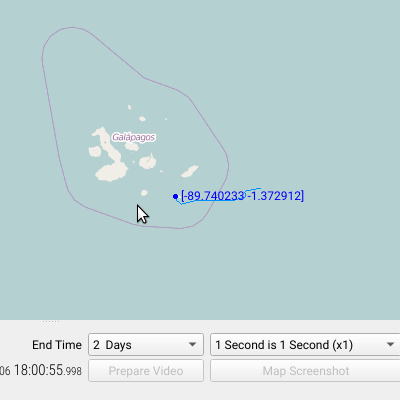
Note that we can now focus on specific regions of interest and also observe whether trajectories have met during this interval.
effective drill-down: step-wise interval restriction
When coping with huge amounts of data effective techniques to drill down to regions of interest becomes more essential. For example, annotations require fast visual inspection and precise interval selections.
Firetail provides controls for the restriction to and shifting of intervals of predefined length:
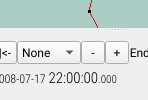
- Select a timestamp that roughly resembles area you wish to analyse using the time slider or map selection.
- Use the drop down menu for interval restriction to select a granularity: ‘hour’, ‘day’, ‘week’ or ‘month’. The closest enclosing interval will be selected e.g. 4-5am given ‘hour/4:33:00’ is selected
- Use ‘+’ and ‘-’ to step forward/backward to the next/previous interval. Start and end are updated accordingly.
Hint: Use the interval restriction to roughly select an interval of interest, then use manual bracketing to further refine to refine the selection.
A sample drill-down down:
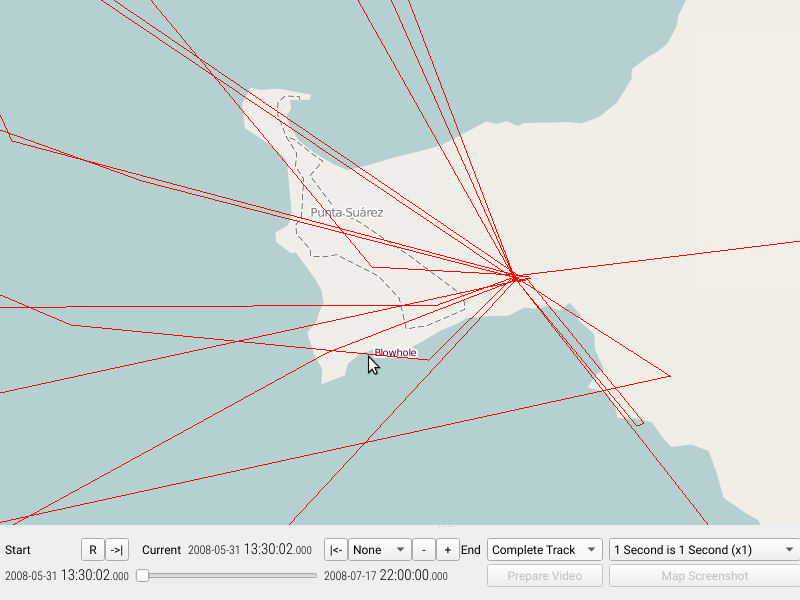
Sample video: interval restriction (mp4)
- A timestamp is selected roughly on the month level
- The interval restriction (jump width) is used to select ‘day’ granularity
- The interval restriction is used to select the correct hour
- The viewport is limited to cut the interval to the nearest hour